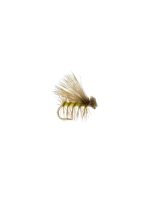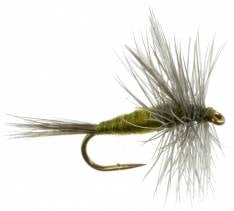Elk Hair Caddis is a popular dry fly used in fly fishing that imitates a caddisfly, a common insect found in many rivers and streams. This fly is characterized by its distinctive hair wings made from elk hair, which provide excellent flotation and visibility on the water.
The body of the Elk Hair Caddis is usually made from a combination of dubbing and hackle, which mimics the segmented body of the caddisfly. The hackle also adds buoyancy to the fly and helps it ride high on the water. The color of the body can vary, but the most common colors are tan, olive, and black.
The Elk Hair Caddis is versatile and can be fished in a variety of water conditions, from slow-moving pools to fast-moving rapids. It is particularly effective during caddisfly hatches, when fish are actively feeding on these insects. This fly can be fished on its own or as part of a tandem rig with a nymph or wet fly.
Overall, the Elk Hair Caddis is a must-have fly for any fly fisherman’s arsenal. Its combination of excellent flotation, visibility, and versatility make it a reliable and effective choice in many fishing situations.
The size of Elk Hair Caddis flies can vary depending on the specific fishing conditions and the preferences of the angler. However, some popular sizes for Elk Hair Caddis flies are:
- Size 12: This size is commonly used in slower-moving water or when fishing for larger trout.
- Size 14: This is a versatile size that can be used in a variety of water conditions and is effective for catching medium-sized trout.
- Size 16: This size is often used when fishing for smaller trout or in faster-moving water.
- Size 18: This smaller size is effective when fishing for trout that are feeding on smaller insects or during a hatch of small caddisflies.
It’s important to note that these sizes are not set in stone, and the best size to use can vary depending on the specific fishing conditions and the preferences of the angler.
Elk Hair Caddis flies can be tied in a variety of colors, but some popular colors include:
- Tan: This is a versatile color that can imitate a range of caddisfly species. It is particularly effective in clear or lightly stained water.
- Olive: This color is often used to imitate caddisflies that are found in rocky or mountainous streams. It can be effective in both clear and slightly murky water.
- Black: This color is often used in low-light or overcast conditions, as it provides a strong silhouette that is visible to fish.
- Brown: This color can be effective when imitating certain caddisfly species or when fishing in water with a lot of algae or debris.
Again, it’s important to note that the best color to use can vary depending on the specific fishing conditions and the preferences of the angler.



Reviews
There are no reviews yet.